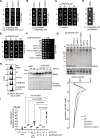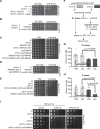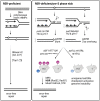Genetic requirements for repair of lesions caused by single genomic ribonucleotides in S phase
- PMID: 36869098
- PMCID: PMC9984532
- DOI: 10.1038/s41467-023-36866-6
Genetic requirements for repair of lesions caused by single genomic ribonucleotides in S phase
Abstract
Single ribonucleoside monophosphates (rNMPs) are transiently present in eukaryotic genomes. The RNase H2-dependent ribonucleotide excision repair (RER) pathway ensures error-free rNMP removal. In some pathological conditions, rNMP removal is impaired. If these rNMPs hydrolyze during, or prior to, S phase, toxic single-ended double-strand breaks (seDSBs) can occur upon an encounter with replication forks. How such rNMP-derived seDSB lesions are repaired is unclear. We expressed a cell cycle phase restricted allele of RNase H2 to nick at rNMPs in S phase and study their repair. Although Top1 is dispensable, the RAD52 epistasis group and Rtt101Mms1-Mms22 dependent ubiquitylation of histone H3 become essential for rNMP-derived lesion tolerance. Consistently, loss of Rtt101Mms1-Mms22 combined with RNase H2 dysfunction leads to compromised cellular fitness. We refer to this repair pathway as nick lesion repair (NLR). The NLR genetic network may have important implications in the context of human pathologies.
© 2023. The Author(s).
Conflict of interest statement
The authors declare no competing interests.
Figures





Similar articles
-
RNases H1 and H2: guardians of the stability of the nuclear genome when supply of dNTPs is limiting for DNA synthesis.Curr Genet. 2020 Dec;66(6):1073-1084. doi: 10.1007/s00294-020-01086-8. Epub 2020 Sep 4. Curr Genet. 2020. PMID: 32886170 Free PMC article. Review.
-
High density of unrepaired genomic ribonucleotides leads to Topoisomerase 1-mediated severe growth defects in absence of ribonucleotide reductase.Nucleic Acids Res. 2020 May 7;48(8):4274-4297. doi: 10.1093/nar/gkaa103. Nucleic Acids Res. 2020. PMID: 32187369 Free PMC article.
-
Apn2 resolves blocked 3' ends and suppresses Top1-induced mutagenesis at genomic rNMP sites.Nat Struct Mol Biol. 2019 Mar;26(3):155-163. doi: 10.1038/s41594-019-0186-1. Epub 2019 Feb 18. Nat Struct Mol Biol. 2019. PMID: 30778235 Free PMC article.
-
Unlike the Escherichia coli counterpart, archaeal RNase HII cannot process ribose monophosphate abasic sites and oxidized ribonucleotides embedded in DNA.J Biol Chem. 2019 Aug 30;294(35):13061-13072. doi: 10.1074/jbc.RA119.009493. Epub 2019 Jul 12. J Biol Chem. 2019. PMID: 31300556 Free PMC article.
-
RNase H2-RED carpets the path to eukaryotic RNase H2 functions.DNA Repair (Amst). 2019 Dec;84:102736. doi: 10.1016/j.dnarep.2019.102736. Epub 2019 Oct 23. DNA Repair (Amst). 2019. PMID: 31761672 Free PMC article. Review.
Cited by
-
A Rfa1-MN-based system reveals new factors involved in the rescue of broken replication forks.PLoS Genet. 2025 Apr 1;21(4):e1011405. doi: 10.1371/journal.pgen.1011405. eCollection 2025 Apr. PLoS Genet. 2025. PMID: 40168399 Free PMC article.
-
Repair of replication-dependent double-strand breaks differs between the leading and lagging strands.Mol Cell. 2025 Jan 2;85(1):61-77.e6. doi: 10.1016/j.molcel.2024.10.032. Epub 2024 Dec 3. Mol Cell. 2025. PMID: 39631395
-
How RNA impacts DNA repair.DNA Repair (Amst). 2023 Nov;131:103564. doi: 10.1016/j.dnarep.2023.103564. Epub 2023 Sep 9. DNA Repair (Amst). 2023. PMID: 37776841 Free PMC article. Review.
References
Publication types
MeSH terms
Substances
LinkOut - more resources
Full Text Sources
Molecular Biology Databases

